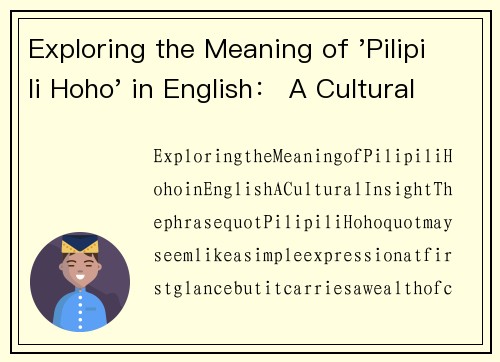Exploring the Meaning of 'Pilipili Hoho' in English: A Cultural Insight
Exploring the Meaning of 'Pilipili Hoho' in English: A Cultural Insight
The phrase "Pilipili Hoho" may seem like a simple expression at first glance, but it carries a wealth of cultural significance, particularly in East African contexts. This article delves into the meaning of "Pilipili Hoho," its origins, its usage in everyday language, and its broader implications in the cultural tapestry of the region. By understanding this phrase, we can gain insights into the rich traditions and social dynamics of the communities that use it.
The Linguistic Roots of 'Pilipili Hoho'
"Pilipili Hoho" is a Swahili phrase that translates to "bell pepper" in English. The term "Pilipili" refers to chili peppers, while "Hoho" specifically denotes bell peppers. Swahili, a Bantu language with Arabic influences, is widely spoken in East Africa, particularly in countries like Kenya, Tanzania, and Uganda. The use of "Pilipili Hoho" in everyday conversation often extends beyond its literal meaning, serving as a metaphor for various aspects of life, including flavor, excitement, and even conflict.
In culinary contexts, "Pilipili Hoho" represents not just a vegetable but a crucial ingredient in many traditional dishes. It embodies the vibrant flavors of East African cuisine, where spices and fresh produce play a vital role. The phrase also reflects the agricultural practices of the region, where farming is a significant part of the economy and cultural identity.
Cultural Significance of 'Pilipili Hoho'
In many East African cultures, food is more than sustenance; it is a means of social connection and cultural expression. The inclusion of "Pilipili Hoho" in meals signifies hospitality and the joy of sharing. When families gather for a meal, the presence of this colorful vegetable often symbolizes abundance and the richness of community ties.
Moreover, "Pilipili Hoho" can also be used in a metaphorical sense to describe situations that are lively or full of energy. For instance, during celebrations or gatherings, one might say that the atmosphere is as vibrant as "Pilipili Hoho," highlighting the joy and excitement of the occasion. This duality of meaning—both literal and metaphorical—demonstrates the depth of language and its ability to convey complex emotions and cultural nuances.
The Role of 'Pilipili Hoho' in Everyday Life
In everyday life, "Pilipili Hoho" is often mentioned in the context of cooking and meal preparation. It is a staple ingredient in many popular dishes, such as stews, salads, and sauces. The vibrant colors and crisp texture of bell peppers make them a favorite among chefs and home cooks alike. The phrase is frequently used in markets, where vendors proudly display their fresh produce, calling out to customers to entice them with the promise of delicious meals.
Additionally, "Pilipili Hoho" can be found in local restaurants and food stalls, where it is featured prominently on menus. The popularity of this ingredient reflects the broader culinary trends in East Africa, where there is a growing appreciation for fresh, locally sourced produce. As globalization influences food culture, "Pilipili Hoho" remains a beloved symbol of traditional cooking methods and flavors.
'Pilipili Hoho' in Art and Expression
Beyond the kitchen, "Pilipili Hoho" has found its way into various forms of artistic expression. In literature, poetry, and music, the phrase is often used to evoke imagery of warmth, community, and the joys of life. Artists and writers draw upon the vibrant colors and flavors associated with "Pilipili Hoho" to create works that resonate with audiences on a deeper level.
For instance, in poetry, a writer might describe a bustling market scene filled with the sights and sounds of vendors selling "Pilipili Hoho," capturing the essence of daily life in East Africa. Similarly, musicians may incorporate references to this phrase in their lyrics, celebrating the cultural significance of food and community. This artistic representation further solidifies "Pilipili Hoho" as a symbol of cultural identity and pride.
The Global Influence of 'Pilipili Hoho'
As East African cuisine gains popularity worldwide, "Pilipili Hoho" has also made its mark on the global culinary scene. Chefs and food enthusiasts are increasingly incorporating bell peppers into their dishes, recognizing their versatility and flavor. This trend has led to a greater appreciation for East African ingredients and cooking techniques, allowing "Pilipili Hoho" to transcend cultural boundaries.
黄色仓库hsc6In international markets, bell peppers are often marketed as a healthy and colorful addition to meals, aligning with global trends toward fresh and nutritious eating. The rise of fusion cuisine has also seen "Pilipili Hoho" being used in innovative ways, blending traditional East African flavors with other culinary traditions. This cross-cultural exchange enriches the global food landscape while honoring the origins of the ingredients.
Conclusion: The Lasting Impact of 'Pilipili Hoho'
In conclusion, "Pilipili Hoho" is more than just a phrase; it encapsulates the essence of East African culture, food, and community. Its significance extends beyond the kitchen, influencing art, language, and social interactions. As we explore the meaning of "Pilipili Hoho," we gain a deeper understanding of the cultural richness that defines the region.
By appreciating the layers of meaning behind this phrase, we can foster a greater respect for the traditions and practices of East African communities. Whether enjoyed in a traditional dish or celebrated in artistic expression, "Pilipili Hoho" serves as a reminder of the vibrant tapestry of life that food and culture create together.
Frequently Asked Questions
What does 'Pilipili Hoho' mean?
- 'Pilipili Hoho' translates to 'bell pepper' in English and is commonly used in East African cuisine.
Where is the phrase 'Pilipili Hoho' commonly used?

- It is primarily used in East African countries, particularly Kenya, Tanzania, and Uganda, where Swahili is spoken.
What is the cultural significance of 'Pilipili Hoho'?
- It symbolizes hospitality, community, and the joy of sharing meals, reflecting the importance of food in social connections.
How is 'Pilipili Hoho' used in cooking?
- It is a staple ingredient in many dishes, adding flavor, color, and nutrition to meals.
Can 'Pilipili Hoho' be found in international cuisine?
- Yes, as East African cuisine gains popularity, 'Pilipili Hoho' is increasingly used in global culinary practices.
What artistic forms incorporate 'Pilipili Hoho'?
- The phrase appears in literature, poetry, and music, often symbolizing warmth and community.
How does 'Pilipili Hoho' reflect East African identity?
- It embodies the region's agricultural practices, culinary traditions, and social dynamics, serving as a cultural symbol.

